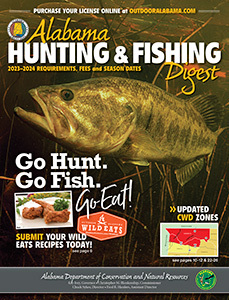Invasive Species
Here in Alabama, we are fortunate to be the 4th most biologically diverse state in the Nation. With over 650 species of native wildlife, both game and nongame, many management considerations are needed to ensure our native wildlife continue to thrive into the future. One management issue on the forefront causing an increased concern for the Alabama Division of Wildlife and Freshwater Fisheries (WFF), as well as other state agencies, is the increasing occurrence of invasive exotic species.
Invasive species have become an increasing problem across the southeast and it can be costly to manage their numbers or the potential negative impacts to our native wildlife. Non-native invasive species come in many forms and can enter the state in various ways ranging from escapes (intentional or unintentional) from the pet trade to hitching a ride on international cargo ships that visit multiple foreign ports prior to coming the U.S. Others can be intentionally introduced, such as feral pigs that were released by settlers, farmers, and Native Americans and are affecting well known for their destructive behavior on agriculture, wildlife and their associated habitats.
In order to combat the rising risks of non-native invasive species in the state, WFF updated the prohibited species regulation in 2020, making it illegal to possess certain species that the U.S. Fish and Wildlife Service have deemed injurious wildlife, or those species that are likely to cause damage, which includes large constrictor species such as Burmese and reticulated pythons. In addition, tegu species were added to Alabama’s prohibited species list, because of the growing concerns with tegu sightings in the state and their potential impacts on ground nesting birds, and in the wake of established populations popping up in surrounding states, including Florida and Georgia.
While we can manage habitat to increase populations of our native wildlife, if invasive species are allowed to establish in our State, increased problems will soon follow for our native wildlife. Regardless how they are introduced, invasive species must be managed or if left unchecked, can wreak havoc on our native ecosystems and native wildlife species. One way that the public can help us combat non-native invasive species is to speak up! If you come across any prohibited non-native invasive species such as a tegu in the wild, or even your own backyard, we want to know. Contact us at 334-242-3469 or [email protected] to report those sightings. It takes all citizens in Alabama to help us manage and protect our native ecosystems from these non-native invasive species.


